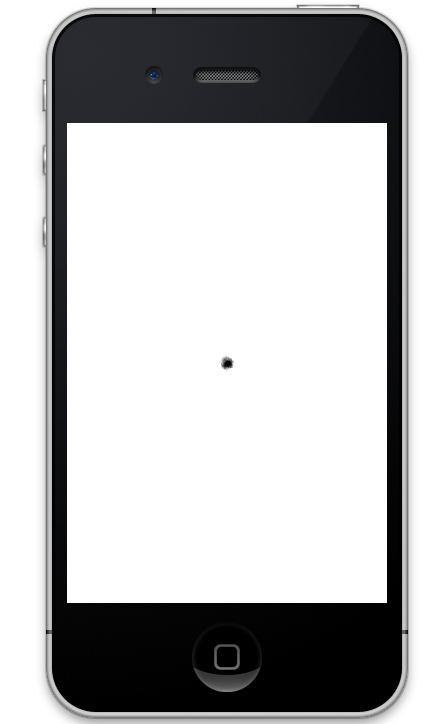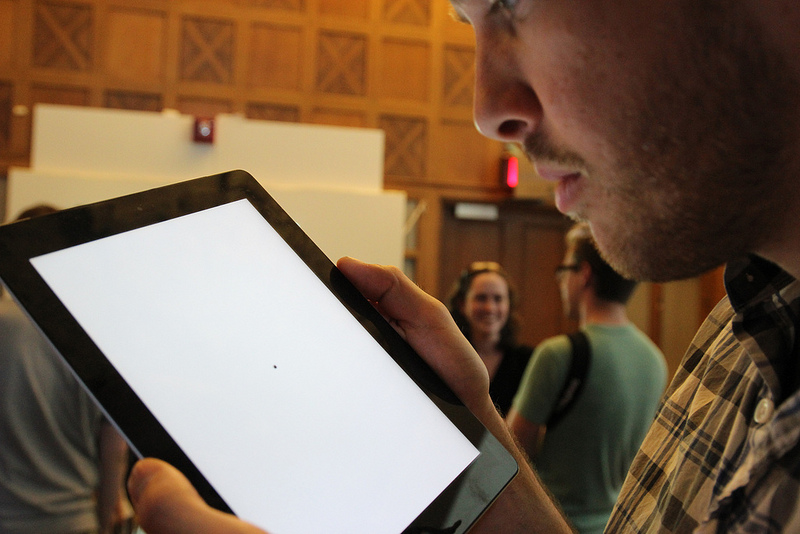Speck and Afterimage — Luke Loeffler
My main goal for the final project was to get my feet wet in iPad development so I teamed up with Deren to work on a system for creating lenticular images. She has already documented the project on the blog, so I’ll mainly discuss some of the additional issues related to development here. Additionally, I created a second app which I describe further below.
The biggest difficulty was getting the lenticules to line up with the pixels on the screen. Unless you have a screen and a lenticular sheet that share a common DPI, there is going to be some degree of “optical beating.” I was able to overcome this somewhat by creating an interface to pinch-scale a calibration image until all you saw was the same color. The image was simply a series of stripes that stepped through the color spectrum repetitively, repeating every 13 columns. When everything was scaled correctly, you’d see all red, or all green, etc. at any given angle. If it was slightly off, it would cycle through the spectrum multiple times in an interference pattern.
Aside from the difficulties of getting resolutions to match, the interface was the second hurdle. We wanted it to be a fun way to combine numerous still images as seen in the documentation video, but this came at the expense of making subtle stereoscopic images. Golan suggested having a continuous recording mode so that the screen could be slowly, carefully, and slightly rocked. If we continue development, we may add this feature possibly by a double-tapping gesture on the screen.
Speck
Recently I bought my first iPad and have been addicted to it. The paper-resolution screen, form factor, and apps like flipboard make it the ultimate content consumption device. Consequently, it has found much use and the situation got me to thinking about consumption, distraction and attention.
In response I created an app, Speck, that is the extreme opposite; a meditative experience that excavates your own thoughts and content. Each time you load it, a small hazy dot is drawn in the middle of the screen for you to stare at. Through the struggle of staring at the speck on the screen, a new awareness of your internal thoughts is generated. The longer you look, the more things you see as your mind grows weary and drifts, tired of focusing.
Although the project is critical of consumptive culture and technology, and its simplicity may lead it to be seen as only a joke, there is also sincerity in its intent. It is a reference to an idea of William James, notable Victorian psychologist, in his Talks to Teachers series about attention.”Try to attend steadfastly to a dot on the paper or on the wall. You presently find that one or the other of two things has happened: either your field of vision has become blurred, so that you now see nothing distinct at all, or else you have involuntarily ceased to look at the dot in question…” [ p. 104 ]. He suggests that the only way to maintain focus is to study it intently, ask questions about it, and try to understand what it is.
But through this process, the mind takes various tangents and creates new stories and narratives which tend to break associative ruts. The tiny, hazy, abstract speck is surprisingly effective as it elicits various trains of thought which often collide with other things I’m thinking about and send them in a new direction.
After submitting the app for review to Apple to be placed in the store, the following response was received which only proves my position:
We found that the features and/or content of your app were not useful or entertaining enough, or your app did not appeal to a broad enough audience…
The original text for the app store:
With the proliferation of content consumption devices there is scarcely a moment when we are not willfully inundating ourselves with noise. Introducing Speck, a meditative app designed to elicit your own internal content. Through the struggle of staring at the speck on the screen, a new awareness of your internal thoughts is generated.

